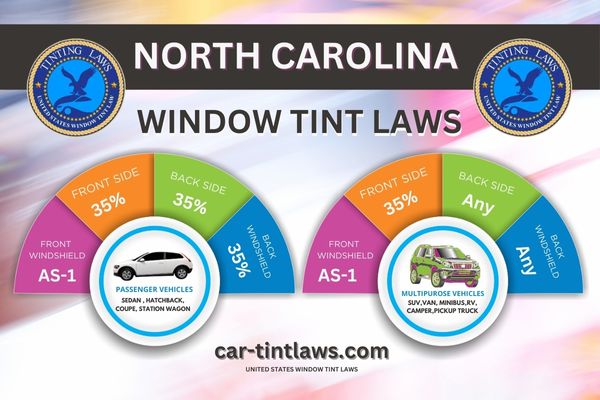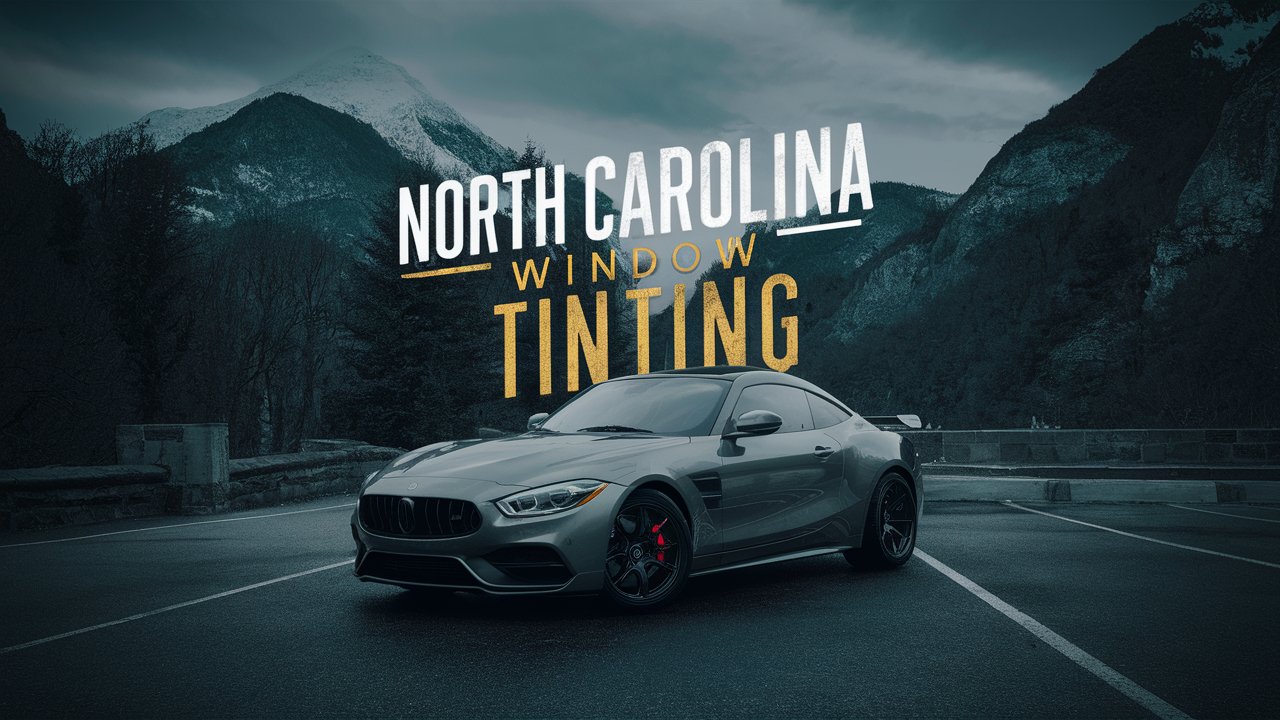If you’re considering tinting your vehicle’s windows in North Carolina, it’s important to understand the specific regulations to avoid fines and guarantee safety.
For example, sedans must allow over 32% of light through all windows except the top 6 inches of the windshield. SUVs and vans have slightly different requirements, with a VLT of 35% on the front windows.
Reflective tint can’t exceed 20% reflectivity, but there are medical exemptions for certain conditions.
Curious about the detailed guidelines and how they might affect your vehicle? Let’s explore what’s necessary to keep in compliance.
Window Tint Darkness in North Carolina
When it comes to window tint darkness in North Carolina, you’ll find specific requirements for both sedans and SUVs or vans.
For all vehicles, the tint must not be darker than 35% Visible Light Transmission (VLT), ensuring a standard level of light passing through.
It’s essential to adhere to these regulations to avoid penalties and fines.
Tint darkness for sedans:
- Windshield: Non-reflective tint is allowed above the manufacturer’s AS-1 line or top 5 inches.
- Front Side windows: Must allow more than 35% of light in.
- Back Side windows: Must allow more than 35% of light in.
- Rear Window: Must allow more than 35% of light in.
Tint darkness for SUV and Vans:
Front Side Windows: Non-reflective tint is allowed above the manufacturer’s AS-1 line or top 5 inches.
Back Side Windows: Must allow more than 35% of light in.
Rear Window: SUVs and vans can opt for any shade on the rear window.
Reflective Tint: SUVs and vans can opt for any shade on the Tint window.
Window Tint Reflection in North Carolina
When it comes to window tint reflection in North Carolina, you need to know that the law sets specific limits for different types of vehicles.
For sedans, the tint reflection must not exceed 20% reflectivity, ensuring it doesn’t distract other drivers.
SUVs and vans also follow this 20% reflectivity rule, so make sure your vehicle complies to avoid fines and maintain road safety.
Tint reflection for sedans:
- Front Side windows: Must not be more than 20% reflective.
- Back Side windows: Must not be more than 20% reflective.
Tint reflection for SUV and vans:
- Front Side windows: Must not be more than 20% reflective.
- Back Side windows: Must not be more than 20% reflective.
- Driver Side window: Must not exceed 20% reflectivity.
- Passenger Side window: Should adhere to the 20% reflectivity limit.
- Rear windshield: Must comply with the 20% reflectivity rule.
- Rear side windows: Reflectivity should not surpass 20%.
- Sunroof: Ensure that the tint does not exceed 20% reflectivity.
Other North Carolina window tint rules and regulations
- Side Mirrors: No restrictions.
- Restricted Colors: In North Carolina, all tint colors are permitted.
- Certificates: Manufacturers of film need to certify the film they sell in the state. Ask your dealer if they are using certified film.
- Stickers: The sticker/label of compliance to identify legal tinting is required between the film & glass on each tinted window.
- Medical Exceptions: North Carolina permits medical exemptions for special tint. For more details about the specific terms of the exemption, consult NC state law.
- Penalties: If caught violating tint laws in North Carolina, you could face a $50 fine along with additional costs totaling $238.

Medical Exemptions for Window Tint Rules in North Carolina
If you suffer from photosensitivity, North Carolina allows you to apply for a medical exception to the window tinting laws.
This medical exception enables you to install after-market tinting that exceeds the state’s standard limits.
To qualify, you’ll need a physician’s signed form, which you can submit through the Drivers Medical Evaluation Program.
This program assesses your medical needs and issues permits for those who meet the criteria.
Medical exceptions are valid for up to five years and must be carried in the vehicle they apply to.
It’s important to follow the specific guidelines set by the North Carolina Division of Motor Vehicles (NCDMV) when seeking a medical exception.
The process includes obtaining a physician’s certification that confirms your photosensitivity and filling out the necessary paperwork.
Once you receive your permit, make sure to display the medical exception sticker properly in your vehicle.
Failure to do so can result in a $200 fine. By adhering to these rules, you can guarantee that you remain compliant while protecting yourself from the harmful effects of sun exposure.
Remember, these exceptions are designed to help those who truly need them, so follow the guidelines carefully.
NC Department of Transportation: Tinted window waiver application form (.pdf file)
North Carolina Window Tint Ticket Cost
Getting caught with illegal window tint in North Carolina can cost you $50 for the ticket itself, but total expenses can reach up to $238.
North Carolina law enforcement takes window tint regulations seriously to uphold road safety standards.
If you’re not compliant with NC tint laws, you could face fines and penalties that go beyond just the initial ticket cost.
The additional costs can accumulate from court fees, administrative charges, and other related expenses.
To avoid these penalties, it’s vital to confirm your vehicle’s window tint adheres to the state’s legal limits.
The law specifies the permissible levels of tint darkness, and any violation is considered illegal tint darkness, subject to fines.
Non-compliance with these regulations doesn’t just affect your wallet; it can also impact your driving record and insurance rates.
Staying informed about the NC tint laws can help you avoid unnecessary expenses and stay compliant.
Understanding the consequences of illegal tint levels in North Carolina is essential for all drivers.
By adhering to the state’s window tint regulations, you can avoid fines, penalties, and maintain a clear and lawful driving experience.
North Carolina DMV Guidelines
When it comes to North Carolina DMV guidelines, you’ll need to be aware of the legal tint percentages, inspection requirements, and available medical exemptions.
Legal tint percentages determine how much light must pass through your vehicle’s windows, varying by window location.
Additionally, vehicles must pass inspection to guarantee compliance, and individuals with medical conditions like photosensitivity can apply for exemptions to use darker tints.
Legal Tint Percentages
In North Carolina, you’re required to have a Visible Light Transmission (VLT) of 35% on all windows for passenger vehicles.
This means that your window tint must allow at least 35% of the light to pass through.
For trucks, SUVs, and vans, the front windows must also have a VLT of 35%, but the back and rear windows can be as dark as you prefer.
When it comes to the windshield, the tint should not extend beyond five inches from the top.
This guarantees that your view remains clear and unobstructed. Additionally, the tint on the windshield must not be reflective.
Reflective tint on other windows is allowed, as long as it does not exceed 20% reflectivity.
It’s important to note that certain colors are prohibited. Specifically, red, amber, and yellow tints are illegal in North Carolina.
These regulations help secure that all vehicles on the road maintain a consistent level of visibility and safety.
By adhering to these guidelines, you’ll be in compliance with North Carolina’s window tint laws, securing both your safety and that of other drivers.
Inspection Requirements
If you’ve had your windows tinted after purchasing your vehicle, you’ll need to pass an after-market window tinting inspection to guarantee conformity with North Carolina’s regulations.
This inspection is vital to confirm your vehicle meets the state-mandated tint darkness limits.
During the inspection, technicians will use an NC-approved tint meter to measure the Visible Light Transmission (VLT) of your windows.
The meter must confirm that the VLT does not exceed 32%.
Conformity with these regulations is necessary not just for avoiding fines, but also for ensuring road safety.
Inspection stations across North Carolina include window tint compliance as part of their regular safety inspections.
If your tint does not meet the required standards, you may need to undergo tint removal or adjustment to bring it into compliance.
The cost for an after-market window tinting inspection is $10, a small price to guarantee both your safety and adherence to the law.
Medical Exemptions
Medical exemptions for window tint in North Carolina are available for individuals with photosensitivity, allowing them to obtain permits through the N.C. DMV Medical Review Program.
If you suffer from photosensitivity to light, you can apply for a medical exception permit.
These permits are valid for up to 5 years, giving you the ability to legally have darker window tint than typically allowed by state regulations.
However, there are restrictions on the number of permits that can be held at one time.
Once you obtain your medical exception permit, you must carry it in the vehicle at all times.
This ensures that you can always present it if asked by law enforcement. Failure to properly display the medical exception permit can result in a $200 fine, making it essential to keep it accessible.
To apply, you’ll need to contact the N.C. DMV Medical Review Program and submit the necessary medical documentation.
Having this permit can markedly improve your comfort and safety while driving, but it’s important to adhere to all guidelines.
By following these steps, you’ll be able to enjoy the benefits of a medical exemption legally and responsibly.
References
Window Tinting – North Carolina DMV
North Carolina Statutes § 20-127. Windows and windshield wipers. (.PDF file)
Frequently Asked Questions
What Is the Darkest Legal Tint in Nc?
You’ll find the darkest legal tinting percentages in NC are 32% VLT for all windows.
Keep safety concerns, UV protection, and privacy benefits in mind during installation.
Regular maintenance and considering alternative options can guarantee compliance.
Can You Have 15% Tint in Nc?
Imagine only 15% of light entering your car—sounds cool, right? While it enhances visual appeal and privacy, 15% tint percentage isn’t legal in NC.
Stick to legal limits to avoid fines, insurance rate hikes, and other legal consequences.
Can You Get Pulled for Window Tint in Nc?
You can definitely get pulled for window tint in NC. Tint enforcement is strict, and police stops are common.
Non-compliant tint visibility can lead to tint fines. However, there are tint exemptions for certain situations.
Stay safe and legal!
Can I Pass NC Inspection With 20% Tint?
In ye olden days, you’d be out of luck with 20% tint darkness. For safety and legal compliance, you need 35% VLT.
Visual clarity, driving, and glare reduction guarantee comfort, UV protection, privacy, and heat reduction.
Conclusion
Understanding and adhering to North Carolina’s window tinting laws is crucial.
You’ll need to make sure your tint’s darkness and reflectivity comply with regulations, whether you drive a sedan, SUV, or van.
Medical exemptions are available for those who qualify, but proper certification is necessary.
Following these guidelines, which are as clear as daylight, helps you avoid fines, pass inspections, and guarantee road safety.
Always check the latest DMV guidelines for any updates.
